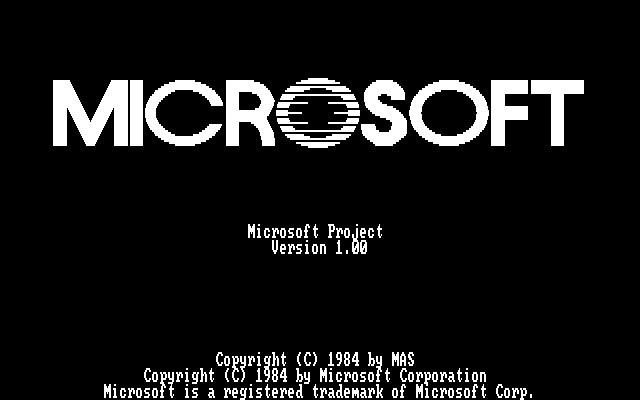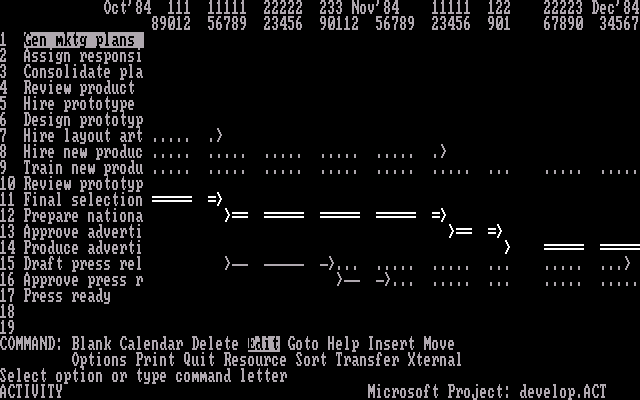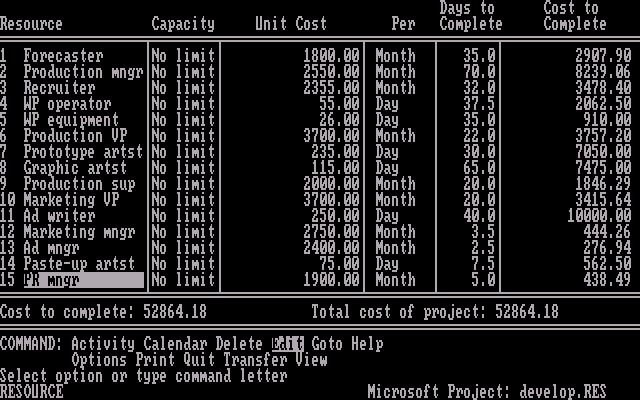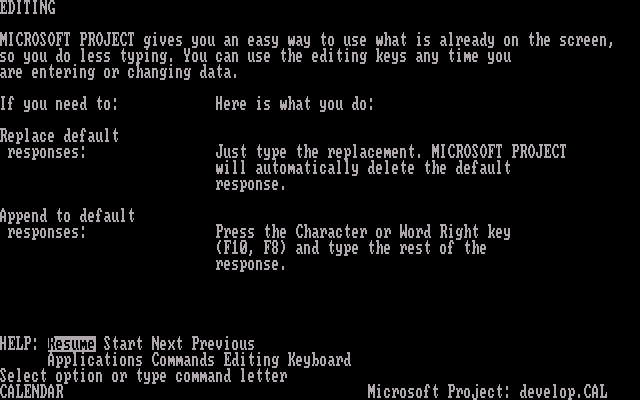Software Spotlight: Microsoft Project 1.00 for DOS
Thanks to Elgibbons for contributing this! Microsoft Project was among Microsoft's earlier professional business application products. First released in 1984 for MS-DOS, Microsoft Project was a professional project management tool that approached projects using the "Critical Path Method" (rather than PERT). It was primarily geared towards resource, scheduling and costing aspects, and targeted business users that had not used project management software before.
https://winworldpc.com/product/project/10-for-dos

Notable features of Microsoft Project 1.0 included its ability to use the Microsoft Mouse, and built in help. It can produce Gantt style charts.
Version 1.0 competed with VisiSchedule, Harvard Project Manager, and PertMaster. It can import and export data between a number of programs.
The DOS version uses a text menu similar to Microsoft Multiplan, Microsoft Word for DOS, and other Microsoft products at the time. It's still better than that awful ribbon interface.
The splash screen attributes both Microsoft and "MAS". The disk also refers to "Micro Applications".

According to Wikipedia, "The idea originated from the vision of Ron Bredehoeft, a former IBM S/E and PC-enthusiast in the early 1980s. This original vision was simple: express the recipe and all preparation for a breakfast of eggs Benedict in project management terms. Mr. Bredehoeft formed Microsoft Application Services (MAS) during the birth of the application and the company later entered an OEM agreement with Microsoft Corporation. Alan M. Boyd, Microsoft's Manager of Product Development, introduced the application as an internal tool to help manage the huge number of software projects that were in development at any time inside the company. Boyd wrote the specification and engaged a local Seattle company to develop the prototype.
The first commercial version of Project was released for DOS in 1984. Microsoft bought all rights to the software in 1985 and released version 2. Version 3 for DOS was released in 1986. Version 4 for DOS was the final DOS version, released in 1986. The first Windows version was released in 1990, and was labelled version 1 for Windows."
Later versions are also discussed on Wikipedia: https://en.wikipedia.org/wiki/Microsoft_Project

This application runs under PC/MS-DOS 1.1x or later, with 128K RAM, a double sided 5.25" floppy drive, and a graphics adapter.
This disk is formatted for DOS 1.x and will not open with tools like Winimage.
This disk is also mis-formatted with 9-sectors, even though it is a 320k 8-sector image. This confuses most disk copiers, as well as Windows 9x.
This version is copy protected. The copy protection method is similar to Microsoft Word for DOS. It uses odd sized sectors on the last track, and one sector with an intentionally misreported size. It will run either from the A or B drive, but can not (as far as I can tell) be installed to a hard drive.
Microsoft Project 2.0 for DOS is reportedly not copy protected. Later versions were not copy protected up until Microsoft Project 2002, which re-introduced copy protection in the form of mandatory product activation.

Like Microsoft Word for DOS, the protected sectors contains some odd ramblings:
So in conclusion, the Winworld collection is now one more disk closer to perfection.
https://winworldpc.com/product/project/10-for-dos

Notable features of Microsoft Project 1.0 included its ability to use the Microsoft Mouse, and built in help. It can produce Gantt style charts.
Version 1.0 competed with VisiSchedule, Harvard Project Manager, and PertMaster. It can import and export data between a number of programs.
The DOS version uses a text menu similar to Microsoft Multiplan, Microsoft Word for DOS, and other Microsoft products at the time. It's still better than that awful ribbon interface.
The splash screen attributes both Microsoft and "MAS". The disk also refers to "Micro Applications".

According to Wikipedia, "The idea originated from the vision of Ron Bredehoeft, a former IBM S/E and PC-enthusiast in the early 1980s. This original vision was simple: express the recipe and all preparation for a breakfast of eggs Benedict in project management terms. Mr. Bredehoeft formed Microsoft Application Services (MAS) during the birth of the application and the company later entered an OEM agreement with Microsoft Corporation. Alan M. Boyd, Microsoft's Manager of Product Development, introduced the application as an internal tool to help manage the huge number of software projects that were in development at any time inside the company. Boyd wrote the specification and engaged a local Seattle company to develop the prototype.
The first commercial version of Project was released for DOS in 1984. Microsoft bought all rights to the software in 1985 and released version 2. Version 3 for DOS was released in 1986. Version 4 for DOS was the final DOS version, released in 1986. The first Windows version was released in 1990, and was labelled version 1 for Windows."
Later versions are also discussed on Wikipedia: https://en.wikipedia.org/wiki/Microsoft_Project

This application runs under PC/MS-DOS 1.1x or later, with 128K RAM, a double sided 5.25" floppy drive, and a graphics adapter.
This disk is formatted for DOS 1.x and will not open with tools like Winimage.
This disk is also mis-formatted with 9-sectors, even though it is a 320k 8-sector image. This confuses most disk copiers, as well as Windows 9x.
This version is copy protected. The copy protection method is similar to Microsoft Word for DOS. It uses odd sized sectors on the last track, and one sector with an intentionally misreported size. It will run either from the A or B drive, but can not (as far as I can tell) be installed to a hard drive.
Microsoft Project 2.0 for DOS is reportedly not copy protected. Later versions were not copy protected up until Microsoft Project 2002, which re-introduced copy protection in the form of mandatory product activation.

Like Microsoft Word for DOS, the protected sectors contains some odd ramblings:
"Copyright 1983 Microsoft Corporation. Tens of thousands of man-hours have been spent to make this product possible, so that you, the user, can use high quality programs. If you steal this software, then we will not receive the fruits of our labor. Stealing software is not just a crime, it is also morally wrong.We have worked hard to produce this program, but we cannot keep working if we are not paid. If criminals force us out of business, then we will no longer be able to produce programs that people can use. If criminals stop stealing our software, then we wibe able to write more programs, make them more advanced, and sell them at a lower price. Think about it. We will prosecute anyone we find stealing our software. If you are caught, it is unlikely that you will ever be able to get a job with any company in this field. Don't risk it. If you are not honest, we will not have mercy on you. This program was brought to you by the hard work of the people at Micro Applications.................. Copyright 1983 by Microsoft Project Sponge Jugglers: Arlo Meander Joe Bascozzi Art Rachnid Bob O. Links Frank Foy 904 Brent Bldg. Lois Arrpeggio Michael States Jim Huden Regnad Kcin Bån Ng Larry Mondello Arturo Mulba Jim Tharp Leroy Gurtne Copyright 1983 by Microsoft Project Sponge Jugglers: Arlo Meander Joe Bascozzi Art Rachnid Bob O. Links Frank Foy 904 Brent Bldg. Lois Arrpeggio Michael States Jim Huden Regnad Kcin Bån Ng Larry Mondello Arturo Mulba Jim Tharp Leroy Gurtne Copyright 1983 by Microsoft Project Sponge Jugglers: Arlo Meander Joe Bascozzi Art Rachnid Bob O
So in conclusion, the Winworld collection is now one more disk closer to perfection.


Comments
This is also early Microsoft's product with copy protection.
Of course it has copy protection just like Microsoft Word 1.xx / 2.00.
(Copy protection type seems to be same but different.)
USING PROJECT WITH A HARD DISK
Use the PROJCOPY program to copy Microsoft Project once onto any hard disk which is compatible with DOS version 2.0 and has a total capacity of at least 2.5 megabytes.
1. To Start PROJCOPY, TYPE PROJCOPY and press the RETURN key.
2. Follow the instructions on the screen to complete the copy procedure.
PROJCOPY will not allow you to make a copy if you have already copied Project to another hard disk. See your DOS 2.0 manual for details about specifying directories and pathnames.
PROJCOPY copies the program files on the Project System disk to a top-level directory called \MSTOOLS. The sample Microsoft Project files, DEVELOP.ACT, DEVELOP.RES and DEVELOP.CAL, are copied to the directory you specify during the PROJCOPY program.
None of the files are copied to the \MSTOOLS directory should be renamed or moved. However, you can move the DEVELOP files to any directory on your hard disk.
The start Project from a hard disk you must either:
1. Change the default directory to the directory containing PROJ.COM before starting Project, or
2. Include the directory containing PROJ.COM in the search path specified in the DOS 2.0 PATH command. Then you can start project from any directory.
BTW, I had noticed those names in the copy protected area looked bogus... but ROFL Googling some of those.
Thanks for inform the installation.
I tested it.
It works on DOS 2.xx well, but It doesn't work on DOS 3.30 correctly, hehehe.
I added screenshot.
viewtopic.php?f=36&t=8165&start=125
Here is additional screenshot.
(Copy protection checking failed via Floppy drive)
(Original disk needed to installation)
(Installation was refused on DOS 3.30)
*Once MS Project 1.00 is installed on HDD, there is no need to insert original key disk on floppy.
I created .PSI and installed on PCE DOS 2.XX.
The install completes well, but will not launch once installed. Perhaps I did not create .PSI correctly.
Also, do you see files in the \MSTOOLS directory once installed?
Oh, I tried to run on 32MB HDD with DOS 3.30
Yes, it can't be installed.
So I tested on IBM 5160 + 10MB HDD with DOS 3.30.
It seems to be installed, but the warning is shown.
Weird. Installing to a hard drive inside PCE, and Project freezes at startup. Installing to a real hard drive on real hardware seems to work fine. The files created on both hard drives are 100% identical.
It seems to be getting past the copy protection, but it does something else different when run from a hard drive. If I copy the files in to QEMU, Project actually gets to the entry screen, but then bombs out when a key is pressed.
BTW, it looks like the copy protection should work the same as Microsoft Word for DOS 1.15. That is, just copy the files from the floppy to a folder such as c:\proj, then create a folder C:\MSTOOLS, create a file named "PRA", and fill it with the text:
That should result in an exactly 256 byte file. The installer makes that file read only, hidden, system, but it doesn't seem to check attributes.
I edited PROJCOPY.COM by using PC-Tools.
0000:0000 E9 6E 19 02
--> Installation number is limited.
0000:0000 E9 6E 19 00
--> Installation number is initialized.